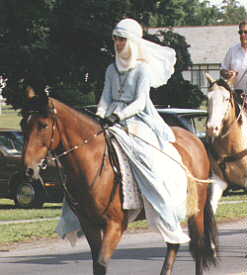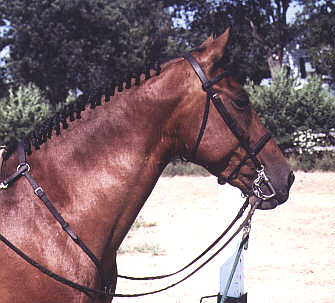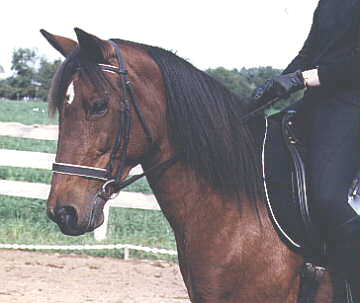In memory of
- Shasta -
With links to info on Cushing's Disease and EPM
![]()


An old-style Morgan, of course...and NOT your average trail horse
![]()
|
Just a smidgen under 14.2 hands, Shasta had a nice way of going (no choppy pony stuff) and was very comfortable under saddle. We'd been practicing schooling level dressage for about 8 years prior to her retirement. For the uninitiated, its the low level version of the ballet-like moves that the Royal Lippizzaner Stallions from the Spanish Riding School in Vienna perform (you know...the pretty white horses that leap in the air...). I couldn't afford many lessons, so we were kinda stuck at this level for a while. But, we were the best darned schooling level pair we could be under the circumstances! Shasta was a sweetheart to work around, and the vet once said he could worm her in traffic! Not a pretty picture perhaps, but a good example of her barn-yard tractability. In all fairness, we weren't always so wonderful together. To make a long story short, she had a mouth of steel and I had the hands to match. I give our French-style dressage training and particularly our incredibly insightful teacher, Linda Puffer, most of the credit. In a sense, she was our mediator/interpretor, and she brought us from distant points to a common ground of communication. It was a long haul, but I finally learned to give Shasta a chance and she learned to trust me to do so. I don't know what Shasta got out of our years together, but she taught me an inestimable amount about the horse/human relationship and about life in general...the most important thing being the paradox, "the only way to gain control is to give it up." We had our bumps along the way and she never balked from communicating when I was doing something wrong, for which I am eternally grateful. For years I thought she was a klutz, when in fact it was me and my inability to understand what she was telling me...in her take-no-prisoners form of communication! She was implacably honest. For years I addressed her as "Witch," but I came to realize that she was a saint for putting up with me and I can't imagine, particularly with what she went through in her final days, that she'd rate anything less than a set of top-of-the-line wings and an extra cushy cloud to sleep on.
Farewell sweet Shasta and thank you for being a part of my
life. |
|
|
Diagnosis: Shasta passed away on June 24th of 2003 at approx. 26 years of age. Immediately following an aggressive floating (she was having trouble eating hay and grass due to hooks on one back molar and an overgrown one on the other side), she suddenly could no longer drink and her grain had to be wetted down to facilitate eating, although it took a couple of days to figure out why she was spending all day in the water bucket. On the 3rd day (Saturday) she was admitted to the clinic, for rapid weight loss and dehydration. An endoscopy showed that her lyrnx was partially paralysed (which explained her very raspy call), but they were unable to detect what was preventing her from swallowing her water. She was put on IV fluids, antibiotics and steriods. At some point they detected that she didn't have much control over her tongue. Her symptoms seemed to point at either: a) nerve trauma, b) Equine Protozoal Myeloencephalitis (EPM), or c) a tumor. The first scenario held out some hope that a nerve was damaged and might regenerate. EPM, while treatable, is very expensive to do so and the condition tends to recur. If it was a tumor, it would be inoperable. She was trying very hard to stay alive, so I decided as long as she was willing, I'd support her. By Thursday, she'd put back on an amazing amount of weight (water weight I guess) and appeared to have somewhat more control over her tongue. They thought she was drinking some, so she was taken off the IV. Her appetite had been good throughout, although it took all day to eat her mash (senior pellets, bran and sweet feed). However on Friday, when I went to check on her progress, I had sincere doubts as to her drinking ability (I think she was getting a good bit of water from her mash) and whether she was ever going to recover enough to live unaided.
Saturday proved to be the clincher. My husband and I went to see her
and watched her very carefully and noticed that while she was making slight
swallowing movements at times, it was only when the bucket was full. She
literally had to dunk half her head in the bucket to raise the level up high
enough inside her mouth so she could swallow some. She even tried tilting
her head sideways and after several minutes, we realized very little was
actually going down. We then spoke to the surgeon, who did another
endoscopy. We discovered that the paralysis of the larynx was complete
(her voice was a mere whisper), and upon looking at her nose straight on,
also noticed that it was twisted to one side, indicating a partial paralysis.
It became clear to me that her condition was deteriorating and that there
was no point in delaying the unavoidable. With a tremendous amount
of difficulty, I authorized an autopsy, spent our last minutes together and
kissed her a final goodbye. Epilogue: The autopsy found a pituitary tumor the size of a golf ball...larger than the surgeon had ever seen before...which perhaps explains her ridiculously high initial test readings. Incidentally, an enlarged tumor was not immediately considered the most likely on the list, as the few horses that they'd come across with it had exhibited epileptic-type symptoms. No one had heard of or seen anything like what we were dealing with. Now it had occured to me that the floating might have damaged the nerves to her tongue, but that didn't explain her larynx or her nose. It's been surmised that the pituitary, which sits at the base of the brain, had become so enlarged that it was impinging on the cranial nerves. There was also a good deal of necrotic (dead) tissue in and around the pituitary. In addition, some of the tissue sent to Cornell showed signs of encephalitis (EPM). The surgeon's best guess was that the trauma of floating her teeth may have pushed up the time clock, but that it was inevitable. Someone suggested that the file probably bashed into her cervical vertebrae and caused the paralysis. In any case, between the Cushings, the EPM and the trauma, my poor mare didn't stand a chance. And inevitable or not, I would've taken whatever time we might've had. One lesson to be had here is to trust your horse's teeth only to an equine dentist, who has the tools to do a proper job without the medieval instruments of torture that most vets and farriers use.
My sincere hope is that her passing wasn't in vain and that something useful
comes of it. She deserves at least that |
|

|

|
| .
The following was written over several years for three beloved canine companions, with the final refrain written in Shasta's memory. To hear the poem read to harp music, click here and listen to selection #5.
Lavender Rose
Life is so precious and fragile,
So with the turning of the leaves,
White is the mantle of winter,
And more, perhaps, to warm my heart
Eyes like two pools in the moonlight,
Now summer's come and I've laid to rest
.
.
- Morgans -
The Original American Sport Horse! .
©
2000-2010, Donna L. Profeta. All rights reserved.
|